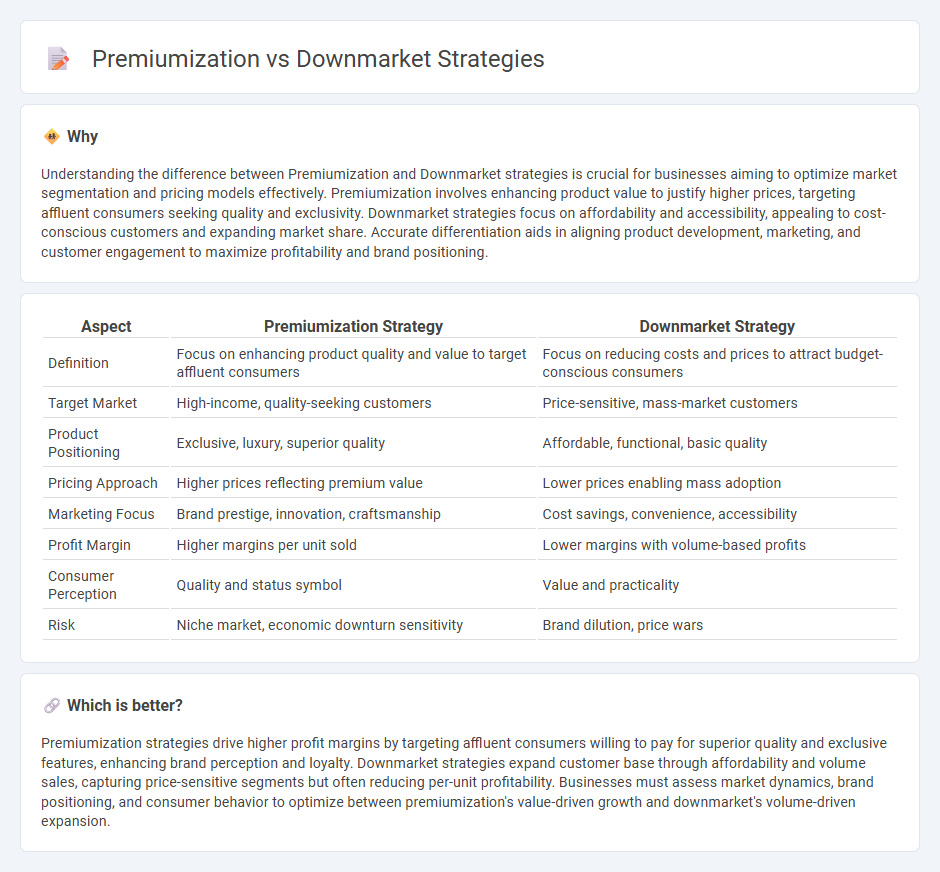
Premiumization strategies focus on enhancing product quality, brand prestige, and consumer experience to target affluent customers willing to pay higher prices. Downmarket strategies prioritize affordability and accessibility, appealing to cost-conscious consumers in competitive markets. Explore how these contrasting approaches shape business growth and market dynamics.
Why it is important
Understanding the difference between Premiumization and Downmarket strategies is crucial for businesses aiming to optimize market segmentation and pricing models effectively. Premiumization involves enhancing product value to justify higher prices, targeting affluent consumers seeking quality and exclusivity. Downmarket strategies focus on affordability and accessibility, appealing to cost-conscious customers and expanding market share. Accurate differentiation aids in aligning product development, marketing, and customer engagement to maximize profitability and brand positioning.
Comparison Table
| Aspect | Premiumization Strategy | Downmarket Strategy |
|---|---|---|
| Definition | Focus on enhancing product quality and value to target affluent consumers | Focus on reducing costs and prices to attract budget-conscious consumers |
| Target Market | High-income, quality-seeking customers | Price-sensitive, mass-market customers |
| Product Positioning | Exclusive, luxury, superior quality | Affordable, functional, basic quality |
| Pricing Approach | Higher prices reflecting premium value | Lower prices enabling mass adoption |
| Marketing Focus | Brand prestige, innovation, craftsmanship | Cost savings, convenience, accessibility |
| Profit Margin | Higher margins per unit sold | Lower margins with volume-based profits |
| Consumer Perception | Quality and status symbol | Value and practicality |
| Risk | Niche market, economic downturn sensitivity | Brand dilution, price wars |
Which is better?
Premiumization strategies drive higher profit margins by targeting affluent consumers willing to pay for superior quality and exclusive features, enhancing brand perception and loyalty. Downmarket strategies expand customer base through affordability and volume sales, capturing price-sensitive segments but often reducing per-unit profitability. Businesses must assess market dynamics, brand positioning, and consumer behavior to optimize between premiumization's value-driven growth and downmarket's volume-driven expansion.
Connection
Premiumization and downmarket strategies are connected through their focus on segmenting consumer markets to maximize revenue by targeting distinct price-sensitive and quality-seeking customer bases. Companies employ premiumization to enhance perceived value and justify higher prices, while downmarket strategies aim to capture volume by offering more affordable alternatives, creating a complementary approach to market coverage. This dual strategy allows businesses to optimize market share and profit margins across diverse economic segments.
Key Terms
Market Segmentation
Downmarket strategies target price-sensitive consumer segments by offering affordable products that maintain essential features, enabling brands to capture larger market shares in budget-conscious demographics. Premiumization focuses on elevating product quality, exclusivity, and brand image to attract affluent customers willing to pay higher prices for superior experiences and craftsmanship. Explore how precise market segmentation can balance these strategies for optimized growth and profitability.
Pricing Strategy
Downmarket strategies involve reducing prices and offering more affordable options to capture cost-conscious consumers, often resulting in higher volume but lower margins. Premiumization focuses on enhancing product quality, exclusivity, and brand perception to justify higher prices and attract discerning buyers willing to pay a premium. Explore the nuances of pricing strategies to understand how businesses optimize value and market positioning.
Value Proposition
Downmarket strategies prioritize affordability and accessibility, targeting price-sensitive consumers by offering basic features and cost-effective solutions. In contrast, premiumization emphasizes enhancing product quality, exclusivity, and superior customer experience to justify higher prices and attract discerning buyers. Explore how aligning value propositions with market segments can optimize revenue and brand positioning.
Source and External Links
7 Strategies for Investing in a Down Market - Downmarket strategies include tax-loss harvesting to offset gains or reduce taxable income, taking advantage of market downturns by thinking long-term, and preparing for market fluctuations with patience.
What To Focus On During a Down Market - Key downmarket strategies involve dollar-cost averaging, avoiding timing the market, rebalancing portfolios, diversifying investments, and considering tax-loss harvesting among other approaches to thrive during downturns.
Three financial strategies for down markets - Effective downmarket strategies include strategic tax planning like converting IRAs at lower tax cost, tax-loss harvesting to offset gains or income, and estate planning techniques such as grantor retained annuity trusts to transfer undervalued assets.
 dowidth.com
dowidth.com